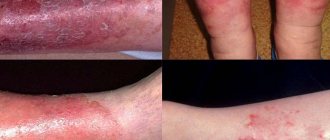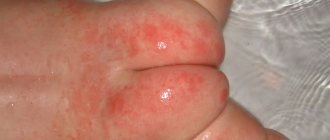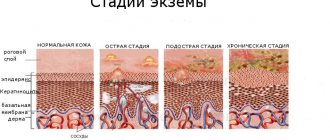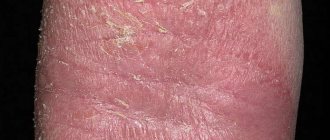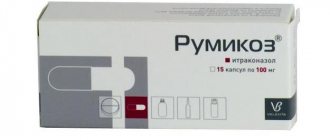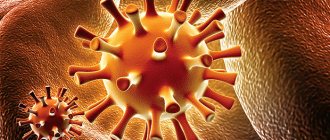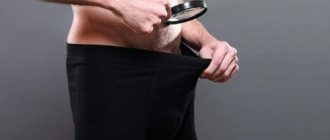Causes of ear dermatitis
Ear dermatitis occurs in both adults and children of different ages and has the following provoking factors:
- immunological;
- infectious;
- mechanical.
Predisposing factors:
- decreased immunity;
- genetic inheritance of allergies;
- infectious and inflammatory lesions of the ears, accompanied by purulent discharge;
- mechanical damage to the outer or inner part of the sink;
- insufficient skin hydration;
- disruption of the gastrointestinal tract;
- poisoning of the body with toxins and harmful substances.
One of the causes of the disease may be seborrheic dermatitis, localized in the hair area and spreading to the ears and other nearby areas.
Causes
The reasons for the development of pathology depend on various factors. This is influenced by both the state of human health and external irritations. Regardless of the type of ear dermatitis, they all have common triggers:
- Immune system dysfunction.
- Hormonal imbalances.
- Tendency to allergies.
- Stress.
- Lack of vitamins.
- Chronic diseases.
Contact dermatitis is caused by external irritants. This may include regularly wearing a material such as plastic or metal on the ears. A similar pathology can be caused by uncomfortable glasses frames. Constantly rubbing against plastic or metal parts causes irritation.
Hearing aids or headphones may contain harmful substances that also cause the development of the disease.
Diseases may also develop while wearing gold jewelry. The fact is that earrings are not made from pure gold. Some alloys contain nickel. They provoke a reaction in the body. In many countries, the use of nickel in jewelry alloys is prohibited.
Classification of the disease
There are several types of ear dermatitis, similar in their symptoms, but formed under the influence of various provocateurs.
Contact – manifests itself when the skin is directly exposed to external irritants.
This type of dermatitis in the ears can be triggered by the following irritants:
- hair care products;
- glasses frames made from materials that cause allergies;
- hair dye;
- ear drops;
- headphones and hearing aids made of low-quality material;
- jewelry with a high nickel content;
- jewelry;
- allergenic food;
- plant pollen;
- household chemicals;
- fluff and fur of pets.
In children, this type of disease can develop due to wearing a headdress made of synthetic fabrics.
Manifests itself in the form of the following signs:
- redness and swelling of the ear in the contact area;
- peeling and itching of the skin.
This type of disease is easily diagnosed and, when the irritant is eliminated, is quickly cured.
Atopic – complicated course of allergy. The most common type of ear dermatitis, most often observed in children.
Occurs under the influence of provoking factors:
- insufficient skin hydration;
- weakened immunity;
- predisposition to allergies.
Clinical manifestations:
- the occurrence of unbearable itching;
- bright red spots and blisters with serous contents;
- formation of crusts in the area of inflammation;
- the appearance of cracks and weeping wounds;
- addition of secondary infections.
It is impossible to completely get rid of the disease, but with the help of treatment, atopic dermatitis can be transferred to a stage of long-term remission without exacerbations.
Seborrheic is the most dangerous type of disease, arising under the influence of a pathogenic fungus on the scalp, and then spreading to the ear area. If left untreated, the infection may spread to the cheeks and neck.
Seborrheic dermatitis in children appears as a result of the residual presence of maternal hormones.
Factors of occurrence:
- hereditary predisposition;
- hormonal imbalances (in adolescents, pregnant women);
- insufficient dose of vitamin B in the body;
- diseases of the gastrointestinal tract, kidneys, liver and other internal organs;
- drug therapy;
- nervous instability.
Characterized by the following features:
- fatty scales on the surface of the ears;
- color change;
- swelling of the skin;
- the appearance of nodular formations with liquid contents, spontaneously opening;
- coarsening and dryness of the epidermis.
In places where seborrheic dermatitis is localized (if it lasts for a long time), scars and eczema remain, which spoil a person’s appearance and disrupt the usual rhythm of life.
Ear dermatitis is distinguished according to the forms of the disease:
Acute form - occurs immediately and entails severe itching and fever. Redness and swelling, a rash in the form of blisters and papules (nodules) are observed. The lesion quickly reaches the ear canal and is accompanied by pain and the appearance of boils. The level of hearing decreases noticeably, which can lead to irreversible consequences.
Chronic form - observed with a prolonged course of the disease. There is ear congestion, peeling of the surface of the auricles, and the appearance of weeping erosions. Skin changes spread to the area around the auricle. It is characterized by periods of intensification of the inflammatory process (with pronounced symptoms) and attenuation of the disease. Phases of exacerbations and remissions will follow each other until the necessary treatment is applied.
How to treat seborrheic dermatitis in the ears
A huge number of factors can provoke ear dermatitis, especially for frequent patients of a dermatologist and allergist. Since this disease can lead to hearing loss, it is necessary to know the causes, symptoms, and measures to prevent this pathology.
What is ear dermatitis
Ear dermatitis is an inflammation of the skin of the external auditory canal and the pinna, resulting from a reaction to irritants of an internal and external nature.
There are 3 forms of this disease:
- Atopic.
- Contact.
- Seborrheic.
The last type is considered the most dangerous, since it can spread to nearby areas of the skin (face and neck).
Causes
The following factors can provoke the occurrence of any form of ear dermatitis:
- weakening of the body's protective function;
- genetic predisposition;
- the presence of a bacterial or viral infection;
- chronic diseases;
- stressful situations;
- purulent discharge and constant ear itching;
- intoxication of the body;
- disturbances in metabolic processes;
- disruptions in the functioning of the digestive system;
- skin diseases;
- the effect of chemicals on the ear canal;
- persistent otitis;
- mechanical damage or ear injuries, which can cause infection to get into the wound.
- incorrectly selected cosmetics or hygiene products;
- the use of hats, hairpins, headphones, hearing aids and glasses, the composition of the material of which can cause allergic reactions;
- individual sensitivity to metal jewelry.
How does it occur in children?
There is an opinion that the causes of seborrheic dermatitis of the ears in childhood are genetic predisposition and the presence of residual maternal hormones in the child’s body.
The disease appears in the first months after the birth of the baby and usually disappears on its own. This does not mean that you should not pay attention to the symptoms that appear and refuse treatment measures.
The main sign of dermatitis will be the presence of greasy scales on the ears, which constantly flake off onto clothing. Dandruff often occurs, which indicates a seborrheic form of ear dermatitis.
In the absence of careful hygienic care and preventive measures, secondary infection occurs, which leads to the need to prescribe antibiotics.
Therapeutic therapy is carried out based on the general condition of the child with external preparations or a weak hormonal agent - hydrocortisone ointment.
Medication
Therapy for pathology is individual in nature, depends on the form of the course and includes the use of the following medications:
- The first thing that is recommended to do in such a situation for both adults and children is to treat the inflammation with hydrogen peroxide, a solution of soda or high-concentration laundry soap.
- Zinc ointment, which has a drying effect, will help eliminate weeping lesions. Also for this purpose, solutions of boric or picric acids are applied to the skin.
- To relieve unbearable itching, antihistamines are prescribed in tablets or injections - Loratadine, Claritin, Suprastin. For children, it is recommended to prescribe medications in the form of drops - Parlazin, Tavegil, Cetirizine.
- To reduce inflammation in seborrheic dermatitis, as in the atopic form, the following drops are allowed - Sofradex, Polydex or Geocorton ointment.
- To treat seborrheic dermatitis in the ears I use antifungal agents in the form of ointments - Mikospor, Naftifin, Lamisil.
- Mandatory use of shampoos with antimycotic action for seborrheic dermatitis - Nizoral, Skin-cap.
- Immunostimulants and vitamins. Increases the body's defense function to fight infection.
- Diet therapy to normalize the functioning of the digestive tract by reducing the volume of fats and carbohydrates, spicy foods. The seborrheic form of dermatitis requires a hypoallergenic diet with the exclusion of citrus fruits, chocolate, coffee drinks and gluten-containing products.
- Drugs that stabilize metabolic processes in the body - Apilak, Enterofuril.
- Physiotherapy, including UHF and radiotherapy procedures.
Important: the entire parotid area and auricle should be cleaned of crusts and pus with special care so as not to damage the skin and avoid deep penetration of infection.
To obtain a highly effective result, treatment must be carried out comprehensively and prescribed only by the attending physician.
Folk
I recommend supplementing therapeutic therapy with traditional medicine in the form of decoctions, infusions and lotions that have an anti-inflammatory effect and relieve symptoms such as burning and itching.
To prepare teas for the purpose of herbal medicine, medicinal plants such as elderberry, strawberry, field bark, juniper, anise, rhubarb, prickly steelhead, sorrel, celery, and beans are used.
For daily dosage, take 1 tbsp. herbs and pour boiling water, as when preparing regular tea.
Herbs that can be bought at a regular pharmacy, St. John's wort and oak bark, which have an antiseptic effect, are used as lotions.
Important: traditional methods are not the main method of treatment.
Are complications possible?
Seborrheic dermatitis often leads to dermatosis of the ear, which is characterized by the development of the fungus Malassezia furfur on the scalp and feeds on the secretions of the sebaceous glands. Furunculosis in the ears can also cause hearing loss in humans. Therefore, treatment should be carried out at the initial stage of the disease, since in the chronic form therapy is much more complex and dangerous.
Symptoms and signs of the disease
The manifestation of dermatitis in the ear in humans is characterized by the individual characteristics of the person. They depend on the general condition of the body, the presence of chronic diseases and the severity of the disease.
The main characteristic sign of dermatitis is the presence of severe itching of the skin, as well as the following signs:
- redness and swelling of the ear;
- peeling of the skin;
- the appearance of bubbles filled with liquid;
- discharge from the ear canal with an unpleasant odor;
- changes in the structure of the skin;
- the presence of wet surfaces on both the outer and inner parts of the ear.
Unbearable skin itching forces people to use cotton swabs, sometimes sharp objects are used that can injure the skin and become a possible cause of a bacterial or fungal infection.
Symptoms
Signs of ear disease are detected immediately. One of the most characteristic is severe itching that occurs both in the ears and behind them. The main symptoms can be identified:
- Dryness and flaking of the skin.
- Weeping skin nodules.
- Swelling and redness of the epidermis on the ear.
- Discharge of pus from the ear, characteristic odor.
- Epidermal pigmentation.
- Seborrheic dermatitis appears as yellow and black crusts.
In the acute course of the disease, symptoms arise suddenly, increasing gradually. As it spreads, the ear canal is affected. The patient begins to experience severe itching, as a result of which he scratches the wounds and provokes the appearance of boils. In the absence of adequate therapy, all this can lead to hearing problems.
Diagnostic measures
In terms of its symptoms, ear dermatitis is similar to other skin diseases, so it is important at the initial stage to determine the type of disease and the allergen that triggered it.
To do this, you should consult a doctor and undergo a diagnostic examination, including:
- inspection of the affected area;
- patient interview;
- blood tests;
- scraping the skin from the affected area;
- immunogram;
- allergy tests with suspected pathogens.
The effectiveness and speed of the recovery process depend on the correctness of the diagnosis.
Treatment methods
Dermatitis can be of different types and severity, so the selection of medications is individual in each case and is carried out directly by the doctor.
The initial stage of treatment is to eliminate the influence of factors that provoked the development of the disease, get rid of itchy skin and follow the prescribed diet.
It is recommended to daily wipe the outside and inside of the ear with hydrogen peroxide, boric acid, and a weak solution of potassium permanganate.
Medicines are also used:
- Therapeutic shampoos for seborrheic dermatitis (Nizoral, Sulsena, Friederm, Sebozol) stop the process of fungal reproduction, promote the healing of damaged skin, and normalize sebum secretion.
- Ear drops (Polydex, Otofa) act on pathogenic organisms and relieve inflammation in the ears.
- Creams, ointments, gels (Fenistil, Losterin, Zinocap, Desyatin) dry the affected surface, reduce skin itching, and promote the healing of dermatological lesions.
- After drying the wet surfaces, use Bepanten, Solcoseryl, Actovegin. They improve nutrition and normalize the metabolism of skin cells, stabilize their division.
- Antihistamines (Suprastin, Loratadine, Zodak) eliminate burning and itching, reduce swelling and reduce inflammation.
- Immunomodulators help the body successfully fight allergens and bacterial infections by strengthening the body's defense reactions.
- Enterosorbents (Enterosgel, Laktofiltrum, Polysorb) are used to remove allergens from the body and reduce intoxication of the body when taking medications.
- Emollients (vaseline, mineral oil, Emolium, Physiogel, Topicrem, Mustella) are used in children with atopic dermatitis to restore the fat layer and maintain the water balance of the skin. Apply to pre-moisturized skin.
- Glucocorticosteroids have varying degrees of activity and have many side effects, so they are prescribed depending on the severity of the disease.
- In complicated cases with concomitant fungal or bacterial infection, antibiotics are used.
As additional methods of treatment, physiotherapeutic procedures are carried out, including ultraviolet therapy and phototherapy.
To avoid relapse of ear dermatitis, you should complete the full course of treatment and follow all doctor’s recommendations.
Seborrhea in the ear: causes, symptoms, treatment
Seborrheic dermatitis (dandruff) on the ear is a disease that can be successfully treated with medications and traditional medicine. The list of drugs will help you choose the most effective medicine.
How to cure seborrheic dermatitis on the ear, recommendations from dermatologists will tell you. To treat dandruff in the area of the auricle and ear canal, various drops, ointments, herbal decoctions, and tablets are used.
Causes of seborrheic dermatitis in the ear area
Seborrheic dermatitis on the ear is a symptom of trouble in the body. In order to cure dandruff and get rid of a discomforting defect in appearance, you need to understand the reasons for its occurrence. Exclusively local treatment is not always effective and even with complete elimination of the symptoms of the disease, relapse is possible.
Seborrheic dermatitis develops in the ear for the same reasons as in any other place on the body.
This disease is one of the manifestations of seborrhea, which is predominantly localized on the scalp and beyond the hair growth line.
The affected area may spread to several areas of the skin:
- ear canal;
- auricle;
- behind the ear area.
Symptoms of seborrheic dermatitis on the ear:
- peeling of the skin;
- peeling of scales of the stratum corneum of the epidermis;
- itching that occurs periodically or constantly;
- redness of the skin in the affected area;
- linear or point injury to the skin.
Causes of seborrheic dermatitis on the ear:
- hormonal imbalance, which can be caused by changes in the body's functioning during puberty;
- thyroid diseases;
- genetic predisposition to the development of seborrheic dermatitis;
- unbalanced diet;
- lack of care or improper care of body skin.
Types of seborrheic dermatitis on the ear
Seborrheic dermatitis in the ear can develop against the background of one of two forms of seborrhea:
Depending on the type of disease, symptoms may vary. With oily seborrhea, oily dandruff is observed, with dry dandruff, dry dandruff is observed. The type of peeling is easy to determine visually.
With oily seborrhea the following are observed:
- greasy sheen;
- peeling skin flakes are covered with an oily film;
- the density and thickness of the plates consisting of dead epidermal cells are more pronounced;
- dandruff has a yellowish tint.
Itching is present in any form of the disease. It causes considerable discomfort, but you can get rid of it quickly enough with the help of medications and remedies prepared according to traditional medicine recipes.
To successfully treat the disease, you need to contact a dermatologist who will try to find out the cause of the pathology. This will prevent possible relapses of the disease.
Treatment of seborrheic dermatitis on the ear with medications
Seborrheic dermatitis is the result of a fungal infection of the skin. The development of pathogenic microflora is most often caused by hormonal disorders. Therefore, in the drug treatment of seborrheic dermatitis, drugs are used that have the following effects:
- antifungal (antimycotic agents);
- anti-inflammatory;
- antipruritic;
- calming.
If the cause of seborrheic dermatitis is a hormonal imbalance, medications containing corticosteroids are prescribed.
Dandruff on the ear can also be a consequence of allergic reactions of the body. In this case, antihistamines are needed.
In case of damage to the ear canal
When seborrheic dermatitis spreads to the ear canal area, Sofradex drops are effective. This complex action drug has anti-inflammatory, antibacterial, antifungal effects.
The composition of the medication includes the glucocorticoid hormone - dexamethasone. Due to this, the drops have an antipruritic effect. Directions for use: 1-2 drops in the ear canal area every 4 hours (3-4 times a day, depending on the severity of the lesion).
You can use Sofradex ointment. It is applied to the skin at the same frequency as drops. Analogues:
- "Betagenot";
- "Garazon";
- "Tobrazon."
In case of skin lesions in the area behind the ear and the auricle
Soderm ointment has a pronounced antifungal effect This remedy is recommended by dermatologists as a 100% effective drug at the initial stage of the disease. The ointment can quickly eliminate itching and stop the progression of seborrheic dermatitis. It is applied to the affected area daily, at least 3 times a day.
The following medications can also be used to treat seborrheic dermatitis on the ear:
- "Retinoic ointment";
- "Salicyl ointment";
- "Birch tar".
Treatment of ear dermatitis should be comprehensive, including topical medications (ointments and drops) and tablets taken orally. The course of treatment lasts from 7 to 14 days.
The ear canal can be washed with solutions of furatsilin and resorcinol. If a cerumen plug is present, you must seek qualified help from an otolaryngologist. You cannot remove the plug yourself; this can lead to injury to the eardrum.
Folk remedies for treating seborrheic dermatitis on the ear
Traditional medicine will help relieve inflammation and provide the required therapeutic effect. But it is unwise to refuse to take medications. Usually. treatment with traditional methods is considered as concomitant therapy.
Ointment based on elecampane
Elecampane is known as a natural antibiotic, anti-inflammatory and decongestant.
Preparations based on it effectively eliminate itching and relieve redness in the affected area. This plant is considered the “little brother of ginseng.”
You can prepare an ointment based on elecampane yourself. To do this you will need the following components:
- elecampane leaves 10 g (1 teaspoon);
- goose or pork fat 50 g.
The components are thoroughly mixed and left to infuse in a dark place. The treatment will be ready for use after 7 days. The ointment is applied to the affected area daily 2-3 times a day. This medicine is stored on the bottom shelf of the refrigerator.
Compresses based on herbal decoctions
Compresses, or as they are colloquially called, “lotions,” are used for external, local effects on the skin. The procedure is simple: a cotton pad or gauze pad is moistened with a decoction prepared from medicinal herbs and applied to the disturbing area.
The frequency of application of compresses depends on the severity of the pathological process. If the disease is at the initial stage of its development, 2-3 lotions per day, lasting 5-7 minutes, are enough. With rapid progression of the pathology, you can increase the number of procedures up to 5 times a day.
for therapeutic effects on seborrheic dermatitis on the ear :
- nettle;
- calendula officinalis;
- Oak bark;
- lavender;
- plantain;
- celandine;
- sage;
- pharmaceutical camomile;
- yarrow.
Decoctions are prepared in accordance with the instructions for use, which are indicated on the packages of herbs. On average, to prepare a medicinal product, it is enough to brew 1 tsp. vegetable raw materials 1 cup boiling water. Infuse the decoction for 15-20 minutes. After which the medicine is ready for use.
Oils for the treatment of seborrheic dermatitis on the ear
To treat dandruff in the area of the auricle, ear canal and behind the ear, you can use oils that have anti-inflammatory and disinfecting effects.
One of the most effective drugs in this category is tea tree oil. It is applied to the affected area 2-3 times a day.
Before the procedure, it is necessary to clean the skin of dandruff using a dry cotton or gauze swab.
In addition to tea tree oil, you can use fir or cedar oil. They have the same range of therapeutic effects.
Procedures must be carried out until the symptoms of the disease are completely eliminated.
When treating seborrheic dermatitis on the ear with folk remedies, regularity of procedures is important. To choose the right drug, you must consult a dermatologist.
Loading…
Source: https://frauwow.com/zdorove/volosy/problemy/perhot/seboreya/na-uhe.html
Traditional medicine in the fight against dermatitis
The use of decoctions, tinctures, lotions, and baths with medicinal plants helps reduce the clinical manifestations of the disease and improve the general condition of the patient.
Recipes:
- 1 tbsp. birch buds, brew 200 ml of boiling water, boil for 15 minutes. and strain. Use for daily wiping of affected areas.
- 1 tsp crushed burdock roots, pour 400 ml of boiling water, leave for 12 hours, then strain. Drink 1/2 cup of warm infusion 3 times a day before meals.
- 2 tsp dandelion leaves and roots, pour 1 glass of water, boil for 10 minutes. Then leave for 8 hours and take 100 ml warm before meals.
- Pour a glass of boiling water over chamomile flowers, strawberry leaves and string in equal quantities (10 g each), boil in a water bath for 10 minutes, then strain and use instead of tea.
- 1 tsp pour 200 ml of boiling water over sage leaves, brew for 2-3 minutes, leave for 30 minutes, strain. Use as lotions.
- Mix 2 g of birch tar with 10 g of petroleum jelly and lubricate areas of inflammation.
- The fruits of Sophora japonica also have anti-inflammatory and antipruritic properties. To prepare a decoction for treating affected surfaces, you need to pour 100 g of dry fruits with 250 ml of boiling water and leave for 20 minutes.
However, it should be remembered that before using traditional treatment methods, it is recommended to consult with your doctor.
Treatment
Important! Only a qualified dermatologist has the right to make a diagnosis and prescribe treatment.
Treatment of ear dermatitis can be divided into several lines. This is a conservative therapy using ointments, creams, drops, and other dosage forms depending on the form. The second is physical therapy, with the appointment of adequate procedures. Third - traditional medicine methods.
Ointments and creams for ear dermatitis
Before application, it is necessary to wipe the areas of inflammation with hydrogen peroxide (3% - solution). You can use soda and soap solutions. Local corticosteroids are used - prednisolone, hydrocortisone, clobetasol. Ointments help get rid of local symptoms: relieve swelling, redness, itching, and reduce inflammation.
For severe itching, antihistamine ointments are prescribed. They contain a drug that blocks histamine receptors, eliminating itching. Special creams are used to moisturize and soften the skin. They need to be used daily, in combination with ointments and drops. These include Vaseline, Bepanten, glutamol and others.
Bubbles in atopic and allergic dermatitis can be wiped with solutions of silver nitrate (2% solution), a solution of boric or picric acid. You can use ointments based on zinc oxide and starch.
In case of severe skin damage and the systemic nature of the disease, the use of systemic glucocorticoids and antibiotics is indicated. For seborrheic form, antifungal drugs are also prescribed for oral administration. And ointments containing drugs such as fluconazole, clotrimazole, and ketoconazole are used topically. The most common cream is Triderm, Trimistin.
For fans of oriental medicine, it is possible to use Chinese ointments, about which you can
Drops and their purpose
Basically, to relieve inflammation inside the auricle and in the external auditory canal, drops based on anti-inflammatory drugs are used. The composition includes both conventional non-steroidal anti-inflammatory drugs (salicylates) and corticosteroids in combination with antibiotics. They are indicated when a bacterial infection is attached. For example, Polydexa (dexamethasone + antibiotic), Otipax (phenazone + lidocaine). Drops are instilled 3-4 drops, 3-4 times a day. In addition to relieving inflammation, they promote analgesia.
Physiotherapy
Today, physiotherapeutic procedures are a method of joint treatment. Here is a list of basic procedures:
Ural irradiation improves metabolic processes and tissue trophism. Laser therapy affects areas of inflammation and leads to faster healing. Irradiate exposed affected areas with radiation from the red or near-infrared part of the spectrum. The latter is used already in the presence of crusts and scales. Phonopharesis based on corticosteroid ointments in the ear area eliminates itching, redness, and pain. In the atopic form, it is also possible to use inductothermy on the adrenal gland area. To maintain immunity and restore defenses, resorts in the Crimea and the Sea of Azov are shown.
Traditional medicine methods
Home remedies include lotions and plant compresses. Rhubarb, juniper, strawberries, and black elderberry are often used. They are poured with boiling water at the rate of 1 teaspoon of dry matter per glass. Take 1 tablespoon several times a day.
Ointments are prepared to lubricate skin with areas of dermatitis. Elecampane root powder in the amount of 2 grams, one hundred grams of animal fat are mixed, placed in a water bath, then cooled. Apply 2-3 times a day.
For antiseptic purposes, lotions based on infusions of lingonberries, walnut leaves, sage, and chamomile are used.
Prevention of ear dermatitis
People who periodically experience ear dermatitis need to adhere to some rules:
- use protective equipment if contact with harmful substances cannot be avoided;
- exclude the use of foods that can cause allergies;
- avoid stressful situations;
- control the temperature and humidity in the living room;
- maintain skin moisture during the heating season;
- select jewelry made from high-quality material;
- wear hats made from natural fabrics;
- increase immunity by taking vitamin supplements and general strengthening of the body;
- select hair care products with special care;
- maintain a daily routine;
- eliminate bad habits (alcohol and smoking);
- Monitor the condition of the skin and prevent it from drying out.
When the first signs of ear dermatitis appear - itching and changes in the condition of the skin - you should immediately contact a dermatologist, since the onset of the disease is easier to stop at the initial stage of development.
How to get rid of seborrheic dermatitis in the ears, the best treatment methods
Of course, dermatitis in the ears is not fatal. But if it is not treated promptly, it can manifest as severe inflammation, which significantly impairs the quality of life.
In addition, in places where seborrheic dermatitis is localized, scars and eczema appear over time, which cannot be called attractive.
Seborrheic dermatitis in the ears can spread to healthy areas of the skin and therefore requires immediate treatment.
What's happened
Seborrheic dermatitis in the ears is manifested by peeling skin, itching and redness. Such manifestations are localized in the ear canal, auricle or behind the ears.
Symptoms of the disease:
- there is a change in the usual color of the skin behind the ears and in the auricle;
- there is slight swelling;
- small nodules appear on the skin containing a clear liquid (they are able to open on their own, forming wet spots that are a springboard for the development of microbes);
- the epidermis is characterized by a dry state and peeling;
- the ear of adults becomes covered with yellow scabs;
- pus or colorless liquid may be discharged from the ear canal, accompanied by an unpleasant odor;
- If the disease is not treated in time, the skin in places where dermatitis is localized becomes rough and covered with pigment spots.
The severity of a skin disease depends on many factors. The more you delay treatment, the more difficult it will be to get rid of the unfortunate peeling.
Doctors, depending on skin type, distinguish 3 forms of dermatitis:
- Dry. White flakes (dandruff) appear. Sebum cannot come to the surface normally, so pores become clogged and signs of dry skin appear. If dandruff is eliminated mechanically, the skin will have a red tint, which indicates inflammation.
- Fatty. Increased sebum production, accompanied by an unpleasant odor. Peeling takes on a yellowish tint. Typically occurs in adolescence.
- Mixed. It is characterized by the presence of several foci: for example, a white rash (dry type) occurs on the skin of the face and ears, and the hair and eyebrows are covered with yellowish scales.
Reasons for appearance
Seborrhea in the ears may appear due to certain circumstances that are related to the health of the organs and systems of the human body. Among the causes of ear dermatitis, doctors identify:
- weakened immune system;
- improper metabolism;
- lack of vitamins, which often occurs in the spring;
- hormonal imbalances, especially during adolescence and pregnancy;
- the presence of chronic diseases of the gastrointestinal tract, kidneys and liver;
- frequent stress;
- genetic predisposition.
There is also contact dermatitis, which can occur due to the following factors:
- wearing jewelry, hearing aids or headphones made of metal that does not suit your skin;
- the use of chemical detergents and dyes that cause allergic reactions on the skin;
- drops for the treatment of otitis media;
- strong compression of hats made of synthetic materials towards the ears.
If ear dermatitis is not treated in time, it can develop into dermatosis.
Important point! Dermatosis is associated with the action of the fungus Malassezia furfur, which feeds on sebum secreted through the skin. The products of its vital activity are toxins that lead to the destruction of the epithelium. Seborrheic dermatosis often affects the ears.
Features of treatment
To cure dermatitis or dermatosis, complex therapy is required:
- general strengthening of the immune system through proper nutrition and a vitamin course;
- local ointments and creams;
- taking antifungal, antiallergic and anti-inflammatory drugs (orally and by injection);
- various lotions based on decoctions from traditional medicine;
- using a special liquid that smoothes out folds on the skin (for example, Castellani).
You should not carry out self-diagnosis, because to determine the type of dermatitis you need to consult a dermatologist or otolaryngologist.
How to fight with drugs purchased at the pharmacy
To dry the skin, use zinc ointment. If there are various swellings and lesions, then they resort to applying boric or picric acid to the affected areas.
Is itching severe? Then purchase antihistamines, such as:
- zodak;
- suprastin;
- loratadine;
- cetirizine;
- Parlasin.
The last two options are also sold in the form of syrup, so they are well absorbed by the child’s body.
If you have atopic dermatitis caused by a number of factors, the following measures are taken:
- Drops are placed into the ear canal. Sofradex solution is considered to be an effective medicine. It not only relieves inflammation and swelling, but is also designed to eliminate unpleasant itching. You can buy an analogue of the medicine - Polydex, which perfectly fights fungi and bacteria.
- A thin layer of corticosteroid ointment is applied to the location of the disease (several times a day). Geocorton, which has an antimicrobial effect, is suitable for children and adults.
- When diagnosing contact dermatitis, of course, eliminate the irritant.
In addition to using various creams and ointments, you can use special shampoos that fight dandruff:
- nizoral;
- skin cap;
- sebozol;
- sulsena;
- and many others.
They include:
- ketoconazole, which blocks the access of nutrients to fungal cells;
- ciclopirox, which fights mycoses;
- zinc, which not only prevents the growth of fungus, but also eliminates inflammatory processes;
- selenium disulfide, which slows down the renewal of skin cells;
- tar (a folk remedy that eliminates peeling).
Ointments and creams to combat seborrheic dermatitis in the ears:
- Selena-based Sulsena paste is a good remedy for the treatment of seborrheic dermatitis. It dries well and eliminates inflammatory processes.
- Glucocorticosteroid creams, ointments and lotions have proven themselves on the positive side. But their use should be carried out after consultation with the doctor.
- Lotions and ointments that contain salicylic acid are designed to soften the skin of the affected areas. They are used before the main drugs with intensive effects on the fungus are applied.
To relieve severe inflammation, a dermatologist may prescribe physical therapy. Exposure to UV rays, cold air and ozone can eliminate even the most severe forms of the disease.
ethnoscience
If you want to spend minimal money on the treatment of ear dermatitis, then pay attention to herbs and potions donated by nature itself.
Of course, unlike highly effective synthesized drugs, you will have to tinker a lot, but traditional medicine has practically no contraindications, and is cheap or even free (if prepared independently).
For treatment, decoctions and infusions are used, as well as vegetable oils. They are applied to a tampon, cotton pad or turunda, and then applied to the location of the inflammatory process.
They can be used for acute seborrhea.
Important point! Eliminating severe manifestations of dermatitis is not enough. To eliminate all symptoms of the disease, complex therapy must be carried out for 2 months.
Folk remedies for eliminating oily seborrhea involve the use of the following gifts of nature:
- St. John's wort herbs;
- sage and chamomile flowers;
- infusion of stinging nettle;
- homemade ointments based on oak bark, burdock and honey.
You can also use tar soap, vinegar lotions and a soda solution (baking soda + water).
To cure dry seborrhea, make lotions from:
- decoction of onion peels;
- infusion of dried nettle leaves;
- linseed oil in symbiosis with violet leaves and sea buckthorn;
- castor oil with the addition of egg yolk;
- a decoction based on burdock roots in combination with lard.
All these compresses and tampons are placed on the affected areas of the skin. After some time, they are removed and the auricle is thoroughly wiped with a cotton pad.
Prevention measures
Even if you eliminate all symptoms of the disease, ear dermatitis may start again. This is why it is necessary to take preventive measures.
You should:
- regularly wash your hair with a special shampoo, selected together with your dermatologist (the use of tar soap is allowed);
- eat right (exclude easily digestible carbohydrates, replacing them with fresh fruits and vegetables, be sure to eat cereals, hard pasta, cheeses, meat and fish; it doesn’t hurt to season your dishes with iodized salt);
- if contact dermatitis has been recorded, then you will have to change your jewelry, headphones or hearing aids;
- do not overcool by protecting your ears from the cold with a hat (only natural fabrics);
- buy a vitamin complex containing zinc, selenium, magnesium at the pharmacy (you can take prenatal vitamins Elevit);
- Remember to regularly wash your ears and use only your own personal hygiene items.
A little about diet
During treatment you need to adhere to a diet . Excludes:
- spicy;
- salty;
- smoked;
- fried food.
Stop eating large quantities of baked goods and sweets, because they contribute to the development of fungus. If you take vegetables and fruits rich in vitamins A, E, B (carrots, apples, cabbage, asparagus, etc.), you can not only strengthen your immune system, but also ensure rapid regeneration of the skin.
Drink as much water as possible (preferably mineral water without gas), because it will help improve your metabolism. You need to drink at least 2 liters of liquid per day.
If you have bad habits, try to give them up, because smoking and alcohol are precisely the factors that, albeit indirectly, provoke the occurrence of dermatitis and dermatoses in the ears. Replace them with sports. Such compensation will only be beneficial.
Thus, seborrhea in the ears is easily eliminated with the help of conventional drug treatment, which, in combination with cosmetics and decoctions from the field of traditional medicine, can eliminate not only the symptoms, but also the causes of the disease. People actively struggling with dermatitis in the ears are advised to follow a diet, hygiene and start eating a balanced diet.

